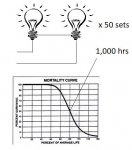Electric-Light
Senior Member
If all 100 were in parallel, you can expect to see 50 remaining after 1,000 hours.
From what I've been told, the time it takes for 10% to go out occurs at about 10% relative life sooner with two in series.

How does this calculation work?
How would I apply it in this example?
top is two independent parallel strings of
B10 of 100,000 hrs in series with two B50 of 25,000 in series. Any component failure stops one of the strings.
bottom is B10 of 60,000 hrs in series with four parallel sets of B50 of 36,000 hrs.
Alternatively, it could be set up up as two sets of ballast + 2 parallel lamps.

From what I've been told, the time it takes for 10% to go out occurs at about 10% relative life sooner with two in series.

How does this calculation work?
How would I apply it in this example?
top is two independent parallel strings of
B10 of 100,000 hrs in series with two B50 of 25,000 in series. Any component failure stops one of the strings.
bottom is B10 of 60,000 hrs in series with four parallel sets of B50 of 36,000 hrs.
Alternatively, it could be set up up as two sets of ballast + 2 parallel lamps.

